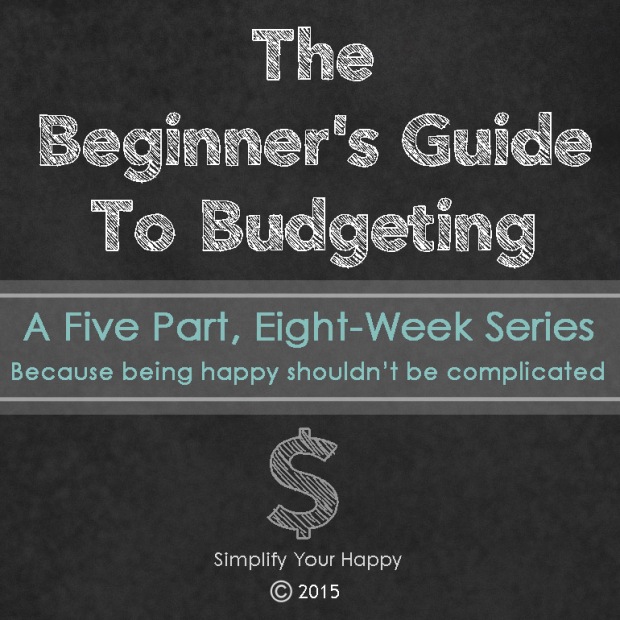This is Part Two – of my five-part, eight-week series The Beginner’s Guide To Budgeting.
Now that you have all those entries, receipts and statements that contain your entire expenses for one full month, what exactly do you do with them?
1. List out the categories you think you spend your money on along the top of a sheet of paper
First we are going to list out all the categories to give us a bigger picture. What categories, or labels did you spend your money on? This exercise is to get them onto paper if you didn’t already and if you have them on paper already it will help categorize even further.
What are some of the basic major categories that you spend your money on? Housing, utilities, food, car maintenance, toiletries, personal (grooming, clothes)…etc. Those are some of the basics that you can start with. As you come across purchases/expenses you don’t have accounted for add a new category for those as you go (and if you used my Monthly Bills & Expenses Worksheet from Part One you are already ahead of the game).
2. Enter your dollar amounts under the applicable column
3. If you can open a spreadsheet and let that do the work for you (I ♥ spreadsheets)
Here’s an abridged version of what it might look like:

4. Don’t forget to make a Misc. column for those items that are hard to categorize (Like little Johnny’s piano lessons or your furry kid’s monthly spa treatment) we’ll figure those out later. We want every amount under a category
Once you’ve placed all your expenses under a categories take a moment and pat yourself on the back. You completed the second step in becoming more aware of your money. Now take a look at the columns. See any common themes? Is one column a little longer (heavier) than another? Is there a lot of items in your Misc column that you didn’t know exactly where to put? Do you see 45 <insert coffee shop name here> entries under your Food category or do you have a Caffeine category all it’s own? You are starting to see how you get a bigger picture overall on where your money is going.
5. Add up the totals for each category and then add up the total of the totals
Now comes the scary part, let’s add up the total of each of your categories and then the total for all the categories for the whole month. That amount, while it might be hard to swallow, is a real tell-tale sign of whether or not you are living within your means.
So from the example above:

This is your total month’s worth of expenses. Pretty scary, huh? Probably a lot more than you think you would spend in one month and there are probably some exceptions in that total – car registration was due this month, Christmas snuck up on you or you suddenly needed brakes for the car and if you weren’t prepared it probably went on a credit card. If you have any of these “life happens” amounts I would move them to their own category for now (don’t include it in your total) and in Part Three I’ll show you how to plan for those Expected and Unexpected Expense Exceptions (EUEE, or better yet, what I like to call the ‘Ex’ factor).

6. Compare that total to your monthly income
Next to that total amount write down your monthly income (usually two paychecks if paid every other week). Now is your income total greater than your total expenses or vise versa?
If your income is larger than your expenses there is hope. If your expenses are larger than your income we can get you help.
And by help, I mean more spreadsheets 🙂 because I ♥ spreadsheets, remember.
This will allow you to find out where this money miscommunication is coming from and determine exactly how to correct it!
7. Break it down
So let’s take it a step further and categorize, or shall we say, fine tune the categories a little more.
For example break down:
- the Food category into Groceries, Out To Eat Evening, Out To Eat Lunches, Coffee, Work Treats, School Lunches.
- Auto could be broken down into Car Payment, Car Maintenance, Gas…you get the point.
So your homework this next week is to take each of the basic categories that you started with and break them down even further. I have provided the printable spreadsheets below, of course, to help you do just that. Or use your own spreadsheets on your computer. Whatever route you choose this will allow you to differentiate between your financial ‘wants’ and ‘needs’ and help you determine how bad you really want something.
You will have your ‘needs‘ – those Fixed Monthly Bills (FMB) that are due every month and your Fixed Monthly Expenses (FME) those things you need to purchase every month, you know, like food to eat and Kleenex to blow your nose with, that stuff. And then you will have your ‘wants‘ the things that I like to call FLUFF or better know as: Fun Life purchases Under False Finances – those impulse items, those things you don’t-really-need-because-you-really-can’t-afford-but–really-REALLY-want-so-it’s-going-on-the-credit-card, yeah, those things. they are FLUFF. And now you will also have the ‘Ex Factor’ items for those unexpected life events that seem to pop up randomly out of the blue or on schedule every year.
 So see you in a week, happy spreadsheet-ing!
So see you in a week, happy spreadsheet-ing!





